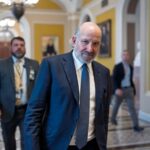
–>
July 14, 2022
I remember it almost as if it were yesterday. It was during the Clinton administration, and I was interviewing for a faculty position at a private liberal arts college, comparable in prestige to the one where I still teach today. I had survived the morning and had just sat down for lunch with a key administrator associated with the department where the position was housed. This was the part of the interview process where the conversation typically becomes more casual and where the main focus is on determining whether or not the candidate is a complete and total boor.
‘); googletag.cmd.push(function () { googletag.display(‘div-gpt-ad-1609268089992-0’); }); }
To be safe, I let her open the conversation, and she wasted no time with idle chit-chat. “What do you think of this impeachment?” she asked. Having thereby established that the bar for polite conversation had been set sufficiently low, I turned my attention to dodging what appeared to be a partisan litmus test. “Oh, I think it’s fascinating,” I exclaimed, before quickly pivoting to a more appropriate topic. “And what about your students?” I asked. “Are they very politically engaged?” For the rest of the day, I managed to avoid disclosing anything about my political views, but in the end, I was not offered the position.
Was my evasiveness a factor in my rejection? Were assumptions made about my political views on that basis? We will probably never know. As with nearly all such decisions made in academe, the shared governance system largely obliterates individual accountability. Search committees are just one example of group decision-making, where a consensus emerges without any clear association between individuals and their comments or recommendations. There is also a tendency to take everyone’s input at face value, assuming good faith on everyone’s part, and striving for decisions that everyone can live with. Not that it would make much difference anyway, as departments, divisions, and colleges tend to replicate themselves over time. In the case of search committees, individual members often favor applicants with whom they identify on some level, and typically the same few standouts rise to the top of everyone’s list. From there, the groupthink endemic to the committee structure itself irons out any remaining differences, and everyone is left to marvel at the obvious superiority of the chosen candidate and the clarity of the choice itself.
Even so, hiring decisions alone are by no means the final word on the enduring composition of the faculty. In theory, the tenure system exists to protect academic freedom. In reality, what is typically a five- to seven-year probationary period, punctuated by multiple interim reviews, provides ample opportunity to weed out dissidents. At the heart of this process is a vaunted peer evaluation system, designed to protect original thinkers against the overreach of administrative drones. In practice, it works about as well as leaving high school cliques to supervise the cafeteria. Even after tenure has been conferred, the faculty mob is loath to loosen its grip, as this same system is used to review candidates for promotion.
‘); googletag.cmd.push(function () { googletag.display(‘div-gpt-ad-1609270365559-0’); }); }
What got me thinking about all of this, and especially my experience with the aforementioned interview, was a recent article for American Thinker in which Jerome Corsi made the case for stripping the federal government of its status as the exclusive provider of government-backed student loans. Embedded in the article was a reference to a report by Mitchell Langbert on a study that he conducted, focused on disparity in voter registration across the two major political parties among faculty at the nation’s top ranked liberal arts colleges. Although the institution where I had the interview was not included in the analysis, my own institution was.
The fact that the figures for our institution were wildly lopsided came as no surprise to me, as it had been documented previously by a faculty colleague. What was more illuminating was that our Democrat-to-Republican ratio of 7.9 to 1 placed us well below the median of 15.6 to 1, not to mention the shocking imbalance of one institution where the faculty included 72 registered Democrats and not a single registered Republican, and another where the ratio was 136 to 1.
From an educational standpoint, and possibly even from a legal standpoint, there is plenty wrong with such uniformity of thought within the nation’s professoriate. Within the theoretical literature on college student development, engagement with diverse perspectives has been linked to both psychosocial and cognitive development, as well as cultivation of complex problem-solving skills. Where this becomes a legal concern is in its centrality to the currently prevailing educational benefit theory of affirmative action in college admissions, which was first introduced in the landmark U.S. Supreme Court case of Regents of the University of California v. Bakke (1978) and further clarified in the subsequent cases of Gratz v. Bollinger (2003) and Grutter v. Bollinger (2003).
This legal theory and its implications for the practice of college admissions will likely take center stage again during the Court’s next session, when it takes up two consolidated cases, Students for Fair Admissions Inc. v. President & Fellows of Harvard College and Students for Fair Admissions, Inc. v. University of North Carolina. Given the Court’s overall record in its most recent session, it appears unlikely that replacing Justice Stephen Breyer with Justice Ketanji Brown Jackson will appreciably shift its ideological balance toward either the left or the right. While the underlying developmental theory supporting recruitment of diverse incoming classes may prevent a gutting of affirmative action in college admissions, continued use of race as a proxy for minority viewpoints seems less likely to be looked upon with favor by the Court.
Based on a commentary that she recently penned for Higher Ed Dive, it would appear that neither the educational nor the legal principles at issue in the dispute have been lost on Lori White, who is a prominent leader in the student affairs field and the president of DePauw University. DePauw was recently named America’s worst campus for free speech by the Foundation for Individual Rights and Expression (FIRE). As a student development scholar, White would understand the significance of viewpoint diversity to the educational benefit theory of affirmative action, and as the leader of an institution that has found its way into the crosshairs of FIRE, she would also understand the importance of walking the talk.
Having lent its imprimatur to the educational benefit theory of affirmative action in admissions, it would seem disingenuous for any institution to cast off this same theory in its consideration of politically conservative applicants for faculty positions. After all, faculty are hired primarily for the purpose of educating others, and politically conservative applicants are expressly distinguished by their underrepresented viewpoints. If the educational benefit theory warrants direct racial discrimination against student applicants from overrepresented groups, in order to attain the indirect benefit of viewpoint diversity, what justification can there possibly be for discrimination against faculty applicants whose own political conservatism would directly enhance viewpoint diversity?
‘); googletag.cmd.push(function () { googletag.display(‘div-gpt-ad-1609268078422-0’); }); } if (publir_show_ads) { document.write(“
To be clear, this is not simply a matter of theoretical abstraction, as the evidence of such discrimination is not easily dismissed on its face. Even a quick scan of the faculty voter registration data presented by Langbert reveals such improbable deviation from that of the general population that it would almost certainly be deemed suspect, were Republicans designated as a protected class. What makes this more troubling is the concept of disparate impact, whereby even discrimination against a non-protected class can be rendered illegal if it disproportionately harms members of a protected class without justification. Although Republicans may not be generally recognized as a protected class, other populations from which they draw relatively high representation are (e.g., Mormons, Evangelicals, veterans, Cuban-Americans). Thus, an organizational climate that is hostile toward expression of mainstream conservative political thought might predictably be viewed as unwelcoming toward those whose embrace of such views is informed in some way by cultural, historical, or religious factors associated with special protections.
Looking beyond party affiliation, it would seem that specific political stances might also draw protection under the broad umbrella of religion. For example, it would seem problematic to use political opposition to abortion or euthanasia as a basis upon which to target a Catholic employee for joining fellow parishioners in a public demonstration to support a pro-life political agenda, in both enactment and profession of their faith (i.e., Sandmanning, if I may coin a new verb). What makes this hypothetical scenario particularly problematic is the possibility that suppression of the political advocacy might actually be driven by animus toward the faith itself. If such actions were to become commonplace, they could have a disparate impact on other protected classes as well (e.g., Mexican-Americans), owing to the demographics of religion.
In a sign that corrective action may be on the horizon, pending cases in the U.S. District Courts in Maryland and Idaho seem to signal receptivity to religiously based protection of at least some political speech within higher education. The details of the cases cut across different political issues and different religions. In such a volatile legal environment, institutional officials do themselves no favors by pursuing only those forms of diversity that pose no challenge to their own biases and prejudices. More significantly, they do a direct disservice to the students whose education and welfare have been entrusted to their care. Where such a dereliction of duty can be demonstrated, corrective measures should be taken “with all deliberate speed.”

Image via Pexels.
<!– if(page_width_onload <= 479) { document.write("
“); googletag.cmd.push(function() { googletag.display(‘div-gpt-ad-1345489840937-4’); }); } –> If you experience technical problems, please write to [email protected]
FOLLOW US ON
<!–
–>
<!– _qoptions={ qacct:”p-9bKF-NgTuSFM6″ }; ![]() –> <!—-> <!– var addthis_share = { email_template: “new_template” } –>
–> <!—-> <!– var addthis_share = { email_template: “new_template” } –>






